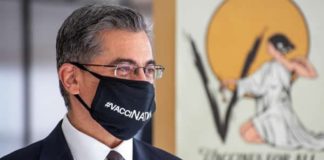
A large clinic in Seattle, Washington that has been tracking rates of HIV and STIs and the sexual behaviour of gay and bisexual men from 2002 to 2018 has found that anal sex without a condom with HIV-discordant or unknown partners has increased since 2013.
This is a reversal of the trend shown in previous research from this cohort, which found that anal sex without a condom with an HIV-discordant or unknown partner had decreased from 2002-2013.
Despite the recent increase of anal sex without a condom, during the study period the testing positivity rate substantially decreased for HIV (by 85%), though it increased for STIs. These results may be due to increased use of antiretroviral therapy (ART) and PrEP, with 94% of study participants living with HIV reporting ART use and 50% of HIV-negative participants reporting having ever used PrEP by 2018.
Led by Dr Christine Khosropour, a professor at the University of Washington in Seattle, this study extends previous research with this cohort and sought to examine the risks for STIs over time associated with different HIV prevention strategies.
Researchers analysed data from routine clinic visits at the Public Health – Seattle and King County Sexual Health Clinic. The clinic has collected detailed sexual health behaviour data from gay and bisexual men since 2001 to track changes in population sexual behaviour.
A total of 52,643 clinic visits from gay and bisexual men were included in the study. Of those, 45,656 visits were from HIV-negative gay and bisexual men, representing 19,354 unique people. The other 6987 visits were by HIV-positive gay and bisexual men, representing 3097 unique people.
Eligible study participants were cisgender men, who were tested for HIV or STIs during their visit and reported a male sex partner in the preceding 12 months. Around half were under 35 years old, around two-thirds were White, and over half reported more than five sex partners in the previous year.
Use of ART and PrEP increased over the study period, with 94% of HIV-positive men reporting ART use in 2018 and the 2014-2018 average being 92 %. In 2013, under 2% of HIV-negative men reported having ever used PrEP, this number had risen to 50% by 2018.
Researchers analysed trends in sexual behaviour by asking men about anal sex and condom use, including data from the first visit in a calendar year by a given person during the study period (n= 38,061).
They sorted men’s behaviour into mutually exclusive categories: 1) no anal sex or consistent condom use with anal sex, 2) serosorting (anal sex without a condom only with partner(s) of the same HIV status), and 3) anal sex without a condom with partner(s) of HIV-discordant or unknown status.
The proportion of men reporting HIV-discordant/unknown anal sex without a condom declined from 2002 to 2012. But it then increased, with 68% of HIV-positive men and 40% of HIV-negative men reporting HIV-discordant/unknown anal sex without a condom in 2018. The proportion of men reporting never using a condom also increased from 2002-2018, almost doubling for HIV-negative men (from 6% to 11%) and tripling for HIV-positive men (from 7% to 21%).
Serosorting increased among all gay and bisexual men from 2002-2010, then trends diverged. Among HIV-positive men, serosorting substantially dropped from 40% in 2011 to 22% in 2018. Serosorting among HIV-negative men continued to increase, going from 27% in 2011 to 42% in 2018. The proportion of men reporting no anal sex and/or consistent condom use during anal sex declined steadily after 2012, with 10% of HIV-positive men and 18% of HIV-negative men reporting no anal sex or consistent condom use in 2018.
Test positivity for early syphilis and urethral and rectal gonorrhoea and chlamydia steadily increased over the study period. HIV-negative men using serosorting were less likely to be diagnosed with rectal gonorrhoea and/or chlamydia after 2012 while HIV-negative men reporting HIV-discordant anal sex without a condom or consistent condom use were still seeing increases from 2012 onwards. HIV-negative men reporting serosorting were significantly less likely to test positive for an STI compared to those reporting HIV-discordant or unknown anal sex without a condom, and significantly more likely than those reporting consistent condom use.
Among gay and bisexual men living with HIV, early syphilis and rectal gonorrhoea and chlamydia increased over the study period, with urethral gonorrhoea and chlamydia remaining relatively stable. This was true regardless of reported behaviour. There was no significant difference in STI risk between HIV-positive men reporting serosorting and those reporting HIV-discordant/unknown anal sex without a condom; however, those reporting serosorting had a significantly higher risk for STIs than those reporting consistent condom use.
In contrast, HIV testing positivity rate declined drastically over the study period, from 3.4 % to 0.05 %, regardless of reported sexual behaviour. This decrease is particularly striking considering it is accompanied by a dramatic increase in behaviours that can increase the risk for HIV transmission, including a doubling of the proportion of HIV-negative men reporting HIV-discordant/unknown anal sex without a condom and a halving in the percent of HIV-negative men reporting consistent condom use between 2013 and 2019.
Gay and bisexual men have been serosorting for decades. Now, people can also factor viral load and PrEP usage into decision-making about sex. This research suggests that the changing behaviour of gay and bisexual men among this cohort may be attributable to the impact of widespread ART and PrEP.
Alongside other research from San Francisco, these findings show how uptake of biomedical HIV prevention strategies can significantly reduce population-level HIV incidence. But even as HIV drops, increases in anal sex without a condom can lead to increased STIs. The authors call for more open discussions about both STI and HIV mitigation between clinicians and gay and bisexual men, and say they recognise that that biomedical approaches to STI prevention may play a role in addressing rising STIs in the era of PrEP and U=U.








